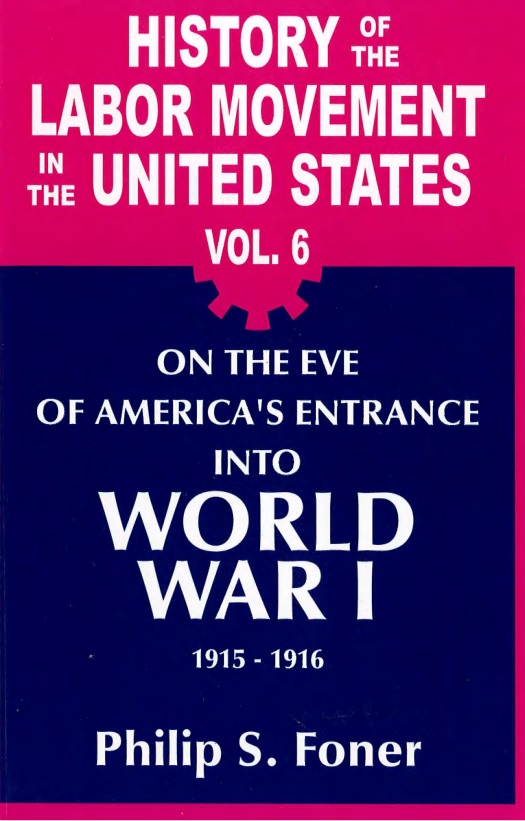Biblioteca / 1980-1989
Philip S. Foner. History of the Labor Movement in the United States. Vol. 6: On the Eve of America’s Entrance into World War I, 1915-1916.
Nueva York: International Publishers, 1982.
3ra reimpresión, 2010.
254 páginas.

CONTENTS
PREFACE
1 – HENRY FORD’S FIVE-DOLLAR EIGHT-HOUR DAY
Why the Five-Dollar Eight-Hour Day?
«Speed-Up King»
Ford Sociological Department
How Representative Was Henry Ford?
2 – AN UNUSUAL STRIKE IN THE ARIZONA COPPER MINES
Grievances of Mexican-American Copper Miners
The Miners Organize
The Miners Strike
The Companies Respond
Company Managers Appeal to Governor Hunt
Governor Hunt’s Unusual Response
Strike Settled
After the Strike
3 – A STEEL STRIKE, A RIOT, AND AN UNUSUAL SEQUEL
«East Youngstown Arson»
Developments in Steel
Conditions in East Youngstown
The Strike and the Riot
Explanations for the Riot
Strike Results
The Sequel
4 – THE STANDARD OIL STRIKES IN BAYONNE, NEW JERSEY, 1915-1916
Gutman’s Status-Conflict Thesis
How Standard Oil of New Jersey Controlled Bayonne
Background for the 1915 Strike
Background for Anti-Labor Violence
Standard Oil Resorts to Violence to Break Strike
Anti-Strike Propaganda
Standard Oil Refuses Arbitration
Strikebreaking Role of Sheriff Kinkhead
The Strike is Broken
Some Concessions to Workers
A New Walkout
Split in the Ranks of Standard Oil Workers
Standard Oil Rejects Strikers’ Demands
Police Mob Violence in Bayonne
What Shall Be Done with These Murderers
1916 Strike is Broken
Anti-Immigrant Bias
John Reed on the Bayonne Strikers
5 – THE NEW YORK CITY TRANSIT STRIKE OF 1916: THE FIRST PHASE
Previous Struggles of Transit Workers
Rampant Anti-Unionism
Working Conditions of Transit Labor
Management Autocracy
Strike Begins in Westchester
Strike Spreads to Bronx
Strike Spreads Still Further
Police Protection for Strikebreakers
Company Propaganda
Role of Socialist New York Call
Truce Settlement
6 – THE NEW YORK TRANSIT STRIKE OF 1916: THE SECOND PHASE
The Truce in Practice
The Second Trans it Strike Begins
PSC Reports
Preparations for a General Strike
The General Strike Fiasco
Why the General Strike Failed
End of theTransit Strike
Aftermath
7 – NEW UNIONISM IN THE GARMENT INDUSTRY
Upheaval in the Garment Unions
Women of the Amalgamated
Struggles of the Amalgamated
A Progressive Women’s Program
Women of the ILG-WU
N.Y. CloakmakersStrikeof 1916
The Fur Workers Forge Ahead
On Words and Deeds
Unions and Gangsters
8 – THE WOMEN’S TRADE UNION LEAGUE ON THE EVE OF WORLD WAR I
A Gloomy Picture
Gompers’ Explanation
The League, The IWW, and the AFL
Emergence of the Woman Organizer
The Minimum Wage
The League and Woman Suffrage
Strained Relations between League and AFL
9 – AN EIGHT-HOUR DAY FOR THE RAILROAD BROTHERHOODS, I: NINE MONTHS OF FRUITLESS NEGOTIATIONS
The Erdman Act
The Newlands Act
Negotiations Begin; The War of Words
The Press Joins the War of Words
The Negotiations
Failure of Mediation
The War of Words Continues
The AFL and the Brotherhoods’ Dispute
10 – AN EIGHT-HOUR DAY FOR THE RAILROAD BROTHERHOODS, II: THE ADAMSON ACT
Background to the White House Conference
The White House Conference
Failure of the White House Conference
Wilson’s Proposal to Congress
The Adamson Act
Implications of the Adamson Act
Railroads Fight the Adamson Act
11 – WOMEN WORKERS ON THE EVE OF AMERICA’S ENTRANCE INTO WORLD WAR I
Economic Crisis
The Unemployed
World War I Brings Economic Recovery
Women Munitions Workers
Strikes for the Eight-Hour Day: Bridgeport
Strikes for the Eight-Hour Day: Pittsburgh
Battling the High Cost of Living
Developments in Seattle
For a National Eight-Hour Day
12 – BLACK WORKERS ON THE EVE OF AMERICA’S ENTRANCE INTO WORLD WAR I
Status of Black Labor in 1914
Decline of the Black Artisan in the South
Exclusion of Blacks from Northern Industry
Impact of Racism
Causes of the «Great Migration»
Recruiting of Southern Blacks for Northern Industry
Emergence of Black Industrial Working Class
13 – ELECTION OF 1916
Relations Between AFL and Wilson Administration
AFL Supports Wilson for Re-election
Democratic Party Platform
Wilson’s Acceptance Speech
Hughes Makes Adamson Act an Issue
Organized Labor Intensifies Support for Wilson
Wilson Narrowly Reelected